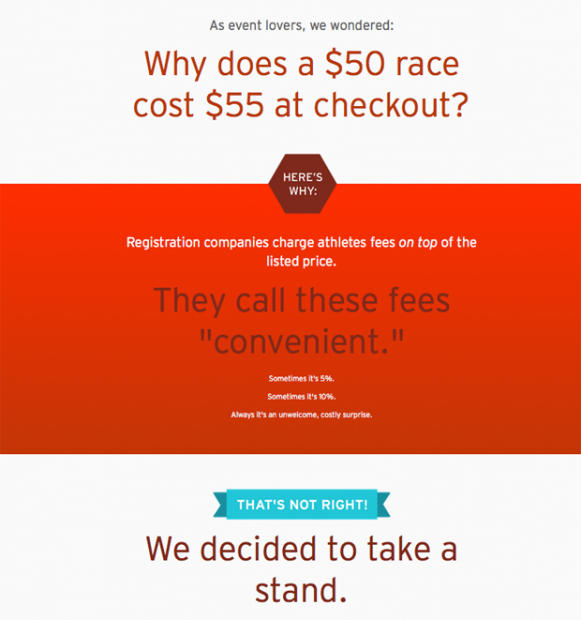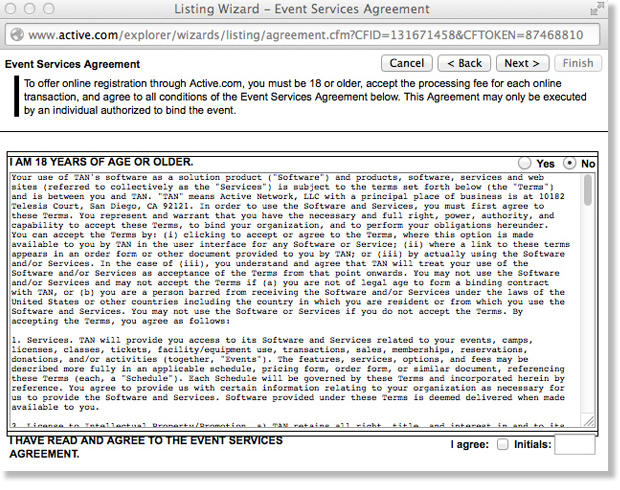Registration or Waterboarding?
Athletes registering online are, or can be, continually vexed during the process. If the consumer, at the point of decision, must steel himself when diving into what he knows from experience is an unpalatable process, how many are just not going to reenter the process at all? This is my fear and my concern. What part of the race experience can be as eagerly anticipated as going in to get the flu shot, and we as an industry are okay with that?
I asked about 40 race directors who they use for registration, and what they value from their registration vendor. Mind, this is now a fragmented marketplace. Among these 40 RDs 16 different registration platforms were in use. But the company with the most adherents was Active, as you might guess, with 12 RDs using it (second was IMAthlete, then Athletepath and ChronoTrack).
I asked these RDs to rank the following features or imperatives. Here are their answers, in the aggregate.
Those RDs using Active Network ranked features in this order, most (1) to least (9) important:
1. Ability to market your race and add to your list of registrants
2. Ability to easily port data to my or my contractor's timing/results software
3. Ease of use for those registering for your event
4. Price charged
5. It's the company others use
6. Samples/Goodie Bag inserts
7. Phone customer service for your staff
8. Phone customer service for your registrants
9. Additional revenue opportunities (selling wetsuits or similar to my registrants)
What is clear is that RDs using Active absolutely value Active as a strategic partner and see Active as driving incremental entries to the race. What is not clear is why customer “ease of use” and the “price charged” were ranked 3rd and 4th in importance by these RDs, since Active is not generally considered a market leader in user friendliness, quick transactions or price charged to the consumer.
Those RDs using registration companies OTHER than Active ranked features in this order, most (1) to least (9) important:
1. Ease of use for those registering for your event
2. Price charged
3. Phone customer service for your staff
4. Ability to easily port data to my or my contractor's timing/results software
5. Phone customer service for your registrants
6. Ability to market your race and add to your list of registrants
7. Additional revenue opportunities (selling wetsuits or similar to my registrants)
8. It's the company others use
9. Samples/Goodie Bag inserts
Those who don’t use Active claim to be most interested in ease of use and low price, each of which is what end-users are crying out for. These companies aren’t interested in the value-adds that Active provides, like help with Samples and Goodie Bag drops, and Active’s robust co-marketing capabilities.
Fees
To me, the stunning disconnect between RDs and end users is the question of how registration fees ought to be displayed, or not. Here’s what one RD wrote to me and I think it sums up the view of the majority: “I like to show registration fees so that my customers don't think I'm gouging them.”
Here’s how it breaks out among the 38 RDs who answered this question:
– I'd like the fee split out, registration fee known at the beginning of or early in the process: 17
– I'd like the fee split out, registration fee only known at the end of the process: 13
– Prefers the fee split out, unclear whether the fee amount early or late the process: 2
– I prefer one all-inclusive fee and this is what I in-fact offer: 6
When we polled this on Slowtwitch, 94 percent of consumers said they preferred just one charge, registration fee inclusive. Among the RDs polled, 84 percent said for their races they split the fee out, though a couple said they are or are considering moving to an all-inclusive pricing model.
Athletepath and Webscorer seem to offer the least expensive fees of any company I could find. BikeReg is cheap as well. Those RDs who use these companies of course like the idea of an all-inclusive price, because it makes them look less expensive.
None of the 12 RDs who use Active prefer the all-inclusive pricing model, certainly because the fee is relatively high and pushes the overall price higher. However, only 9 of the 28 respondents not using Active prefer the standard model of showing fees at the end (they would like to see the fees advertised at or near the beginning of the registration process) and 8 of them either offer all-inclusive fees or are going to that model next year.
This is a circle that must be squared, going forward. Either Slowtwitchers are extremely uncharacteristic of the triathlon community at large; or Slowtwitchers are asking for something they think they want but in reality they will punish the RDs for higher fees; or consumers are telling the truth, and they’ll reward rather than punish RDs who choose the all-inclusive pricing model.
Too Many Questions
What information does a registration company need in order to transact? Your name and address. Your gender and age. Okay so far? There’s your T shirt size. And of course your payment info. If registration companies ask questions beyond these a number of you start complaining. Now, I talk to a lot of these registration companies and they say they don’t get the complaints. My fear? Many consumers aren’t complainers. They just tire of the process and don’t come back.
Why do companies ask more questions? Two reasons. First, they want your data to port into metrics that help RDs market their races. Remember the imperatives above? How those who use Active almost universally value their ability to act as a strategic ally in filling up events? You can’t be that ally if you don’t have data. So, in a way, the data you the consumer provides, while some of it might seem intrusive and is certainly unnecessary to the task at hand, isn’t just to be nosy.
However, I spoke to the owner of one registration company who said Active asks more questions than is needed to help their contracted RDs promote. He said the questions are really for Active’s matrix, because of every business silo in which Active is engaged. Of course he would say that, since he’s a competitor to Active. Still, this is a common view about Active and it’s either true or it’s a messaging problem Active hasn’t solved.
The Account
Reason #2 for asking more questions than necessary: ambitious attempts to create whole new social platforms for athletes. If you have established profiles on Facebook, LinkedIn, Strava, Match.com, Athlinks or, bless your heart, your Slowtwitch Reader Forum Profile, questions are asked. Information solicited. Let’s not kid ourselves, you want that information known. You want it out there. Not all of it. You’re choosy. But if you have a profile at Athlinks you want your race results up there to be seen by the world. If you’re on Match you want people to know you value long walks on the beach. The trick is to not get uppity and offended when information unnecessary to the process is sought. The social media engine doesn’t know what questions will give you offense.
The trick, if you’re that social media engine, is to not give offense. An example is Athletepath and this is a very interesting company. (Its simple, in-Active’s-face message is on its site and it’s the image here.)
Athletepath is a social media platform. This is an ambitious endeavor. It wants to be Facebook for endurance athletes. Which is what every registration company wants. Heck, it’s what I’d like to have at Slowtwitch. It’s the holy grail. But Athletepath is infusing more energy and excellence into the attempt than most, because this is the goal.
Initially it was the only goal. It gets a lot of its data from timing companies. But at a certain point getting over the data hump is the critical task, there’s only so much time before you either breach the summit or you don’t, and Athletepath took the affirmative act of becoming a registration company in order to absorb and integrate more users into its social media platform.

Most consumers to whom I talk don’t mind Athletepath’s approach during registration. Maybe they ask their questions with butter and syrup. Maybe a part of it is that Athletepath is very, very inexpensive in its registration fees. It charges 30 cents + 2.9%, and most of that 3% is sucked up in credit card charges beyond anyone’s control.
Athletepath’s gambit is to make money, or eventually make money, off its strength as a social network. Any company, Active included, Events.com, and every entity that asks for an account to be set up, understands that the eventual strength is in having that account. If you have 10 million user accounts that’s something. If you have 10 million guests coming to the site to use you for registration, that’s a small fraction of something.
The question, to me, is what the landscape is going to look like in a year. Many or most of those companies charging very low fees are either going to be absorbed, or be funded or kept alive via some other revenue stream or model. Being asked to set up an account is an imposition for a consumer, but it might be what helps keep the registration costs down. If being a member is seen as a benefit, such as in Athletepath’s case, then consumers enjoy a double-win: a social media platform that works for them, and very cheap reg costs subsidized by the social platform.
Autofill
One major gripe from consumers is the lack of autofill. It’s laborious to have to type in all the data time after time. Of course, one advantage to having an account (versus being a guest) is that the fields, or at least no-payment fields, are pre-populated. That’s a reasonable expectation. However, over the last few years we’ve had the great diaspora, where a lot of different registration companies are getting used, so you might have to have 4 different accounts with registration companies for the races you’ll do in a season.
I admit I’m a little out of my depth on this. I’m assured that most or all registration companies support auto-fill on their platforms. And your own web browser supports it, if so-enabled. But I never know who’s filling in the fields: Firefox or the registration company.
Who’s Registered?
I’ll be very interested to see where this goes. This is a desired feature in the bike racing community, but it’s an insular group, everyone knows everyone. Nobody in bike racing seems to be in witness protection. But there’s blowback to this in triathlon. We seem to be more fussy about letting people know our business.
Opt-in, Opt-out
If there is anything that drives registrants crazy, this is it. Many consumers feel it’s like whack-a-mole, where you need to uncheck boxes signing you up for lists or services and if you miss filling something in and are redirected back the boxes are repopulated with checks you have to again uncheck.
I don’t know what to say about this. There’s no excuse for opt-out. Unless, perhaps, the opt-out process is easy. One check. Or uncheck, as it were.
The problem is that while no registration company wants to admit this, the basic functionality of race registration is a commodity technology. Webscorer, BikeReg and Athletepath have established a floor price. That downward price pressure, and the more widespread knowledge among consumers that this is an available rate, has created a problem for registration companies. They need to make their money in some way other than simply race registrations. Hence the sometimes onerous and seemingly unnecessary questions and expansive time-suck when trying to register for a race.
In my opinion, the race directors must address this. It is not the fault of race directors or consumers that registration companies have infrastructures or investors that can’t be pleased by the paltry returns from just pure registration. But it is the RD’s fault for assenting to a process that is so distasteful to so many of their own customers. It’s the RD who takes the affirmative act of choosing a registration company. These RDs must weigh the benefits of a robust strategic partner with the popular revolt among their customers against processes that are cumbersome and painful.



